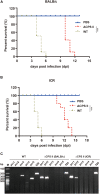A Carbamoyl Phosphate Synthetase II (CPSII) Deletion Mutant of Toxoplasma gondii Induces Partial Protective Immunity in Mice
- PMID: 33519775
- PMCID: PMC7840960
- DOI: 10.3389/fmicb.2020.616688
A Carbamoyl Phosphate Synthetase II (CPSII) Deletion Mutant of Toxoplasma gondii Induces Partial Protective Immunity in Mice
Abstract
Toxoplasma gondii is an obligate intracellular protozoan parasite. T. gondii primarily infection in pregnant women may result in fetal abortion, and infection in immunosuppressed population may result in toxoplasmosis. Carbamoyl phosphate synthetase II (CPSII) is a key enzyme in the de novo pyrimidine-biosynthesis pathway, and has a crucial role in parasite replication. We generated a mutant with complete deletion of CPSII via clustered regularly interspaced short palindromic repeats (CRISPR)/cas9 in type-1 RH strain of T. gondii. We tested the intracellular proliferation of this mutant and found that it showed significantly reduced replication in vitro, though CPSII deletion did not completely stop the parasite growth. The immune responses induced by the infection of RHΔCPSII tachyzoites in mice were evaluated. During infection in mice, the RHΔCPSII mutant displayed notable defects in replication and virulence, and significantly enhanced the survival of mice compared with survival of RH-infected mice. We tracked parasite propagation from ascitic fluid in mice infected with the RHΔCPSII mutant, and few tachyzoites were observed at early infection. We also observed that the RHΔCPSII mutant induced greater accumulation of neutrophils. The mutant induced a higher level of T-helper type-1 cytokines [interferon (IFN)-γ, interleukin (IL)-12]. The mRNA levels of signal transducer and activator of transcription cellular transcription factor 1 and IFN regulatory factor 8 were significantly higher in the RHΔCPSII mutant-infected group. Together, these data suggest that CPSII is crucial for parasite growth, and that strains lack the de novo pyrimidine biosynthesis pathway and salvage pathway may become a promising live attenuated vaccine to prevent infection with T. gondii.
Keywords: CRISPR/Cas9; Toxoplasma gondii; carbamoyl phosphate synthetase II; immunization; vaccine.
Copyright © 2021 Zhuo, Du, Ding, Lou, Zheng and Lu.
Conflict of interest statement
The authors declare that the research was conducted in the absence of any commercial or financial relationships that could be construed as a potential conflict of interest.
Figures






Similar articles
-
Genetic identification of essential indels and domains in carbamoyl phosphate synthetase II of Toxoplasma gondii.Int J Parasitol. 2009 Apr;39(5):533-9. doi: 10.1016/j.ijpara.2008.09.011. Epub 2008 Oct 21. Int J Parasitol. 2009. PMID: 18992249 Free PMC article.
-
Effect of deletion of gra17 and gra23 genes on the growth, virulence, and immunogenicity of type II Toxoplasma gondii.Parasitol Res. 2020 Sep;119(9):2907-2916. doi: 10.1007/s00436-020-06815-z. Epub 2020 Jul 20. Parasitol Res. 2020. PMID: 32686022
-
De novo pyrimidine biosynthesis is required for virulence of Toxoplasma gondii.Nature. 2002 Feb 21;415(6874):926-9. doi: 10.1038/415926a. Nature. 2002. PMID: 11859373
-
Immunization With a Live-Attenuated RH:ΔNPT1 Strain of Toxoplasma gondii Induces Strong Protective Immunity Against Toxoplasmosis in Mice.Front Microbiol. 2019 Aug 13;10:1875. doi: 10.3389/fmicb.2019.01875. eCollection 2019. Front Microbiol. 2019. PMID: 31456786 Free PMC article.
-
Mast cell activator compound 48/40 is not an effective adjuvant for UV-attenuated Toxoplasma gondii vaccine.Parasitol Res. 2017 Aug;116(8):2347-2353. doi: 10.1007/s00436-017-5522-y. Epub 2017 Jun 1. Parasitol Res. 2017. PMID: 28573462
Cited by
-
Human Conjunctival Transcriptome in Acanthamoeba Keratitis: An Exploratory Study.Cornea. 2024 Oct 1;43(10):1272-1277. doi: 10.1097/ICO.0000000000003545. Epub 2024 May 21. Cornea. 2024. PMID: 38771726
-
Advances in Toxoplasma gondii Vaccines: Current Strategies and Challenges for Vaccine Development.Vaccines (Basel). 2021 Apr 21;9(5):413. doi: 10.3390/vaccines9050413. Vaccines (Basel). 2021. PMID: 33919060 Free PMC article. Review.
-
A live attenuated RHΔompdcΔuprt mutant of Toxoplasma gondii induces strong protective immunity against toxoplasmosis in mice and cats.Infect Dis Poverty. 2023 Jun 15;12(1):60. doi: 10.1186/s40249-023-01109-9. Infect Dis Poverty. 2023. PMID: 37322556 Free PMC article.
References
LinkOut - more resources
Full Text Sources
Other Literature Sources

